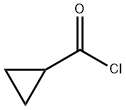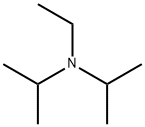Cyclopropanecarbonitrile
Synonym(s):Cyanocyclopropane;Cyclopropyl cyanide
- CAS NO.:5500-21-0
- Empirical Formula: C4H5N
- Molecular Weight: 67.09
- MDL number: MFCD00001269
- EINECS: 226-836-8
- SAFETY DATA SHEET (SDS)
- Update Date: 2025-12-15 14:23:52

What is Cyclopropanecarbonitrile?
Chemical properties
clear colorless to faintly yellow liquid
The Uses of Cyclopropanecarbonitrile
Cyclopropanecarbonitrile is a cyano substituted cycloalkane. Cyclopropanecarbonitrile is an Impurity of pazufloxacin mesylate (P211000).
The Uses of Cyclopropanecarbonitrile
Cyclopropanecarbonitrile is used to prepare cis and trans crotonitrile and allyl cyanide. Further, it reacts with phenylmagnesium bromide to give cyclopropyl-phenyl ketone-imine.
Properties of Cyclopropanecarbonitrile
| Boiling point: | 135 °C (lit.) |
| Density | 0.911 g/mL at 25 °C (lit.) |
| refractive index | n |
| Flash point: | 91 °F |
| storage temp. | Sealed in dry,Room Temperature |
| solubility | Chloroform, Methanol (Slightly) |
| form | Liquid |
| color | Clear colorless to faintly yellow |
| Specific Gravity | 0.905 |
| Water Solubility | Miscible with water. |
| BRN | 635790 |
| Exposure limits | NIOSH: IDLH 25 mg/m3 |
| CAS DataBase Reference | 5500-21-0(CAS DataBase Reference) |
| NIST Chemistry Reference | Cyclopropanecarbonitrile(5500-21-0) |
| EPA Substance Registry System | Cyclopropanecarbonitrile (5500-21-0) |
Safety information for Cyclopropanecarbonitrile
| Signal word | Danger |
| Pictogram(s) |
 Flame Flammables GHS02  Skull and Crossbones Acute Toxicity GHS06 |
| GHS Hazard Statements |
H226:Flammable liquids H315:Skin corrosion/irritation H319:Serious eye damage/eye irritation H335:Specific target organ toxicity, single exposure;Respiratory tract irritation |
| Precautionary Statement Codes |
P210:Keep away from heat/sparks/open flames/hot surfaces. — No smoking. P280:Wear protective gloves/protective clothing/eye protection/face protection. P301+P310:IF SWALLOWED: Immediately call a POISON CENTER or doctor/physician. P303+P361+P353:IF ON SKIN (or hair): Remove/Take off Immediately all contaminated clothing. Rinse SKIN with water/shower. P305+P351+P338:IF IN EYES: Rinse cautiously with water for several minutes. Remove contact lenses, if present and easy to do. Continuerinsing. |
Computed Descriptors for Cyclopropanecarbonitrile
Cyclopropanecarbonitrile manufacturer
JSK Chemicals
3Y
Phone:+91-9879767984
Whatsapp: +91-9879767970
product: Cyclopropane carbonitrile, 98% 99%
New Products
4,4-Difluoropiperidine hydrochloride tert-butyl 9-methoxy-3-azaspiro[5.5]undecane-3-carboxylate Indole Methyl Resin N-Isopropylurea N,N-Dicyclohexylcarbodiimide(DCC) MELDRUMS ACID 5-METHYLISOXAZOLE-4-CARBOXYLIC ACID Magnessium Bis glycinate Zinc ascorbate 1-bromo-2-butyne 2-acetamidophenol 9(10H)-anthracenone Erythrosin B, 4-Piperidinopiperidine 2-((4-morpholinophenylamino) (methylthio) methylene) malononitrile 2,4-dihydroxybenzaldehyde 3-(4-morpholinophenylamino)-5-amino-1H-pyrazole-4-carbonitrile Methyl 2-methylquinoline-6-carboxylate 2,6-dichloro-4-nitropyridine 4-Bromo-2-chlorobenzonitrile 2-(benzylamino)acetic acid hydrochloride 4-(tert-Butoxycarbonylamino)but- 2-ynoic acid 3,4-dihydro-2H-benzo[b][1,4]dioxepine 1-Phenyl-1-cycloprppanecarboxylicacidRelated products of tetrahydrofuran








You may like
-
 5500-21-0 Cyclopropanecarbonitrile 98%View Details
5500-21-0 Cyclopropanecarbonitrile 98%View Details
5500-21-0 -
 Cyclopropane carbonitrile, 98% 99%View Details
Cyclopropane carbonitrile, 98% 99%View Details
5500-21-0 -
 Cyclopropanecarbonitrile 99% (GC) CAS 5500-21-0View Details
Cyclopropanecarbonitrile 99% (GC) CAS 5500-21-0View Details
5500-21-0 -
 Cyclopropanecarbonitrile 97% CAS 5500-21-0View Details
Cyclopropanecarbonitrile 97% CAS 5500-21-0View Details
5500-21-0 -
 Cyclopropanecarbonitrile, 98% CAS 5500-21-0View Details
Cyclopropanecarbonitrile, 98% CAS 5500-21-0View Details
5500-21-0 -
 Cyclopropyl cyanide CAS 5500-21-0View Details
Cyclopropyl cyanide CAS 5500-21-0View Details
5500-21-0 -
 Cyclopropyl Cyanide CAS 5500-21-0View Details
Cyclopropyl Cyanide CAS 5500-21-0View Details
5500-21-0 -
 Cyclopropanecarbonitrile CAS 5500-21-0View Details
Cyclopropanecarbonitrile CAS 5500-21-0View Details
5500-21-0
Statement: All products displayed on this website are only used for non medical purposes such as industrial applications or scientific research, and cannot be used for clinical diagnosis or treatment of humans or animals. They are not medicinal or edible.
